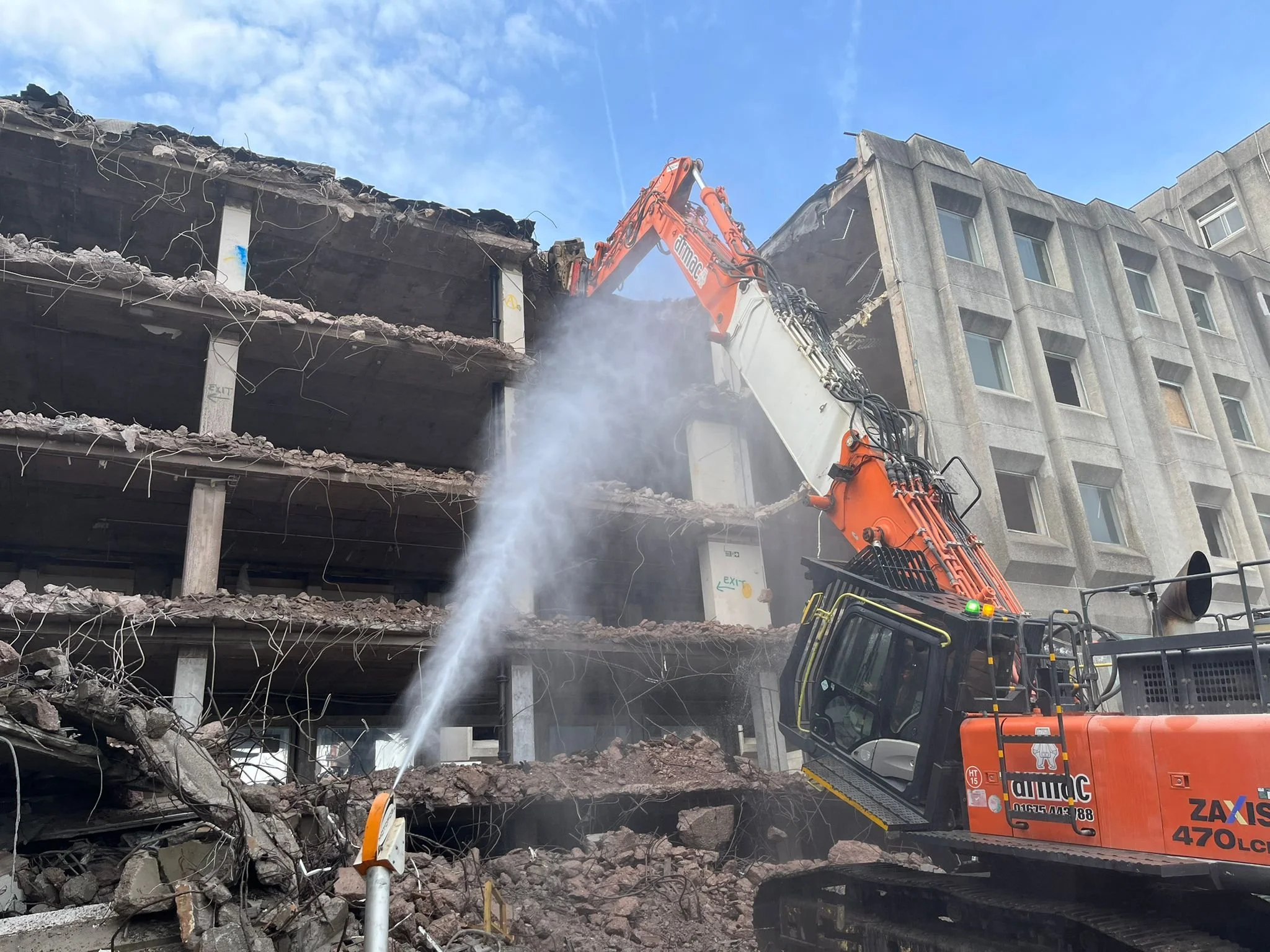NEW TOWN HOUSE
Client
Warrington Borough Council
Location
Warrington
CDM Role
Principal Contractor
Programme
November 2022 - March 2023
Appointed as Principal Contractor by Warrington Borough Council to undertake the asbestos removal, soft strip, and demolition (including foundations) of two former office block accommodations. The scheme was in central Warrington with a mixture of occupied commercial and residential properties within proximity. Our knowledge and experience of city centre schemes was a lead factor in the selection process, along with our tender submission which scored highly on all quality responses.
Overview
New Town House was a 5 storey U shaped building, with an extended leg to one side. It butted up to Quattro Building to form a central open quadrangle. Both buildings had an in-situ reinforced concrete frame, precast concrete cladding panels and flat roofs with mineral felt covering. The frame to each building had a down stand beam at each of the long sides and a shallow down stand spine beam at the centre. The floor slabs spanned between the perimeter and spine beams. The open quadrangle and public access to the buildings were all at ground floor level.
The scheme was conducted in-line with CDM 2015 Regulations, the BS:6187 Code of Practice for Full & Partial Demolition and all other associated statutory and legal regulations. We fully resourced the scheme with company employed staff and company owned plant and equipment, all of which remained on site until successful project completion. All buildings within the scheme were demolished including substructures.
Dust Suppression
Our CAT352 UHD demolition machine is fitted with on board dust suppression equipment. A set of water spray nozzles are fitted to the end of its arm, powered by an onboard hydraulic powered high pressure water pump. This is fed by pipe from a water hydrant or water bowser. These nozzles sprayed a dense mist with a wide pattern into and around the area where the work tool was operating to wet and suppress any dust created.
Dehaco Tera dust suppression units were also sited nearby (but outside the expected debris radius) for targeted dust suppression at the workface and/or to provide a curtain of water mist to trap dust emissions. Given the location nuisance mitigation was our highest priority.
Pre-Cast Concrete Panels
Experience dictates that pre-cast panels can present a significant risk during demolition as the vibration created during the process can cause the failure of the panels fixing, resulting in the panels becoming loose. Therefore, given the city centre location we arranged pre-commencement inspections by one of our preferred structural engineers. Despite some of the fixings being in good condition, the condition of all needed to be known to ensure that our high reach technique proposals were the most appropriate approach. The panels were reported as being secure, confirming our more efficient and cost-effective method could be adopted.
Soft Strip
Internal soft strip consisted of the removal of non-fixed elements by company employed CCDO Demolition & Refurbishment operatives.
Asbestos Removal
The most prevalent asbestos containing products within the survey were floor tiles, bitumen based adhesive and textured coating, all of which was removed prior to demolition under a single stage airlock, utilising our fully licensed asbestos removal division, Armac Environmental.
Demolition
Demolition was conducted by CAT 352 high reach demolition specific machines equipped primarily with a VT40 with C jaw concrete cutting attachment. Supporting machines (CAT 336) processed arisings at ground level and demolished lower floor levels 1 and 2.
The buildings were demolished in phases which included out of hours operations under a road closure to elevations considered as being sensitive. Closures were managed in house by our dedicated pre-construction team, who also ensured that all services to the building were isolated in a timely manner so as not to affect strict programme timelines. Phases 1 and 2 saw the machine work starting in the east car park on Orford Street, heading towards the centre courtyard. Phase 3 and 5 was the demolition of two areas of the south east and south west of the site which due to their locations near to the edge of the site and their extra height are to be demolished as mentioned out of hours. Phases 4 and 6 were both conducted within the original site boundary and under the same RAMS. Demolition progressed from the edge preceding towards the lift and stair cores. Supporting lift cores were the final areas to be demolished.





